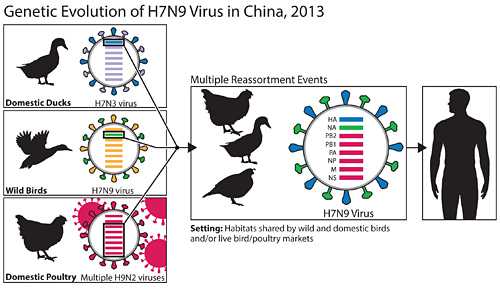Transmission of Influenza Viruses from Animals to People
Influenza A viruses are found in many different animals, including ducks, chickens, pigs, whales, horses, seals and cats.
Influenza B viruses circulate widely only among humans.
Influenza A viruses are divided into subtypes based on two proteins on the surface of the virus: the hemagglutinin (H) and the neuraminidase (N). There are 18 different hemagglutinin subtypes and 11 different neuraminidase subtypes. All known subtypes of influenza A viruses have been found among birds, except subtype H17N10 and H18N11 which have only been found in bats. Below is a table showing the different hemagglutinin and neuraminidase subtypes and the species in which they have been detected.
Aquatic birds including gulls, terns and shorebirds, and waterfowl such as ducks, geese and swans are considered reservoirs (hosts) for avian influenza A viruses. Most influenza viruses cause asymptomatic or mild infection in birds; however, clinical signs in birds vary greatly depending on the virus. Infection with certain avian influenza A viruses (for example, some H5 and H7 viruses) can cause widespread, severe disease and death among some species of birds. Avian influenza A viruses are designated as highly pathogenic avian influenza (HPAI) or low pathogenicity avian influenza (LPAI) based on molecular characteristics of the virus and the ability of the virus to cause disease and mortality in chickens in a laboratory setting.
Pigs can be infected with both human and avian influenza viruses in addition to swine influenza viruses. Infected pigs exhibit signs of illness similar to humans, such as cough, fever and runny nose. Because pigs are susceptible to avian, human and swine influenza viruses, they potentially may be infected with influenza viruses from different species (e.g., ducks and humans) at the same time. If this happens, it is possible for the genes of these viruses to mix and create a new virus.
An example of reassortment is the Asian lineage H7N9 virus. The eight genes of the H7N9 virus are closely related to avian influenza viruses found in Asian domestic ducks, wild birds and domestic poultry. Experts think multiple reassortment events led to the creation of this H7N9 virus. These events may have occurred in habitats shared by wild and domestic birds and/or in live bird/poultry markets, where different species of birds are bought and sold for food. As this diagram shows, the Asian H7N9 virus likely obtained its HA (hemagglutinin) gene from domestic ducks, its NA (neuraminidase) gene from wild birds, and its six remaining genes from multiple related H9N2 influenza viruses in domestic poultry

Another example of reassortment is the H7N9 virus. The eight genes of the H7N9 virus are closely related to avian influenza viruses found in domestic ducks, wild birds and domestic poultry in Asia. Experts think multiple reassortment events led to the creation of the H7N9 virus. These events may have occurred in habitats shared by wild and domestic birds and/or in live bird/poultry markets, where different species of birds are bought and sold for food. As this diagram shows, the H7N9 virus likely obtained its HA (hemagglutinin) gene from domestic ducks, its NA (neuraminidase) gene from wild birds, and its six remaining genes from multiple related H9N2 influenza viruses in domestic poultry.
While it is unusual for people to get influenza infections directly from animals, sporadic human infections and outbreaks caused by certain avian influenza A viruses have been reported.
Hemagglutinin
| SubType | People | Poultry | Pigs | Bats / Other |
|---|---|---|---|---|
| H1 | 
|

|

|
|
| H2 | 
|

|

|
|
| H3 | 
|

|

|
Other Animals |
| H4 | 
|

|
Other Animals | |
| H5 | 
|

|

|
|
| H6 | 
|

|
||
| H7 | 
|

|
Other Animals | |
| H8 | 
|
|||
| H9 | 
|

|

|
|
| H10 | 
|

|
||
| H11 | 
|
|||
| H12 | 
|
|||
| H13 | 
|
|||
| H14 | 
|
|||
| H15 | 
|
|||
| H16 | 
|
|||
| H17 | 
|
|||
| H18 | 
|
Neuraminidase
| SubType | People | Poultry | Pigs | Bats / Other |
|---|---|---|---|---|
| N1 | 
|

|

|
|
| N2 | 
|

|

|
|
| N3 | 
|
|||
| N4 | 
|
|||
| N5 | 
|
|||
| N6 | 
|

|
||
| N7 | 
|

|
Other Animals | |
| N8 | 
|

|
Other Animals | |
| N9 | 
|

|
||
| N10 | 
|
|||
| N11 | 
|
For more information about other influenza viruses, please go to Other Flu Web Sites.
- Page last reviewed: April 12, 2017
- Page last updated: April 12, 2017
- Content source:
- Centers for Disease Control and Prevention, National Center for Immunization and Respiratory Diseases (NCIRD)
- Page maintained by: Office of the Associate Director for Communication, Digital Media Branch, Division of Public Affairs


 ShareCompartir
ShareCompartir